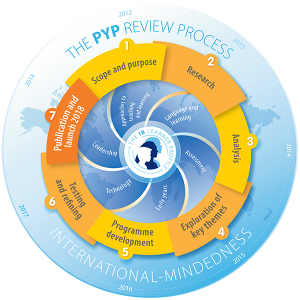
The PYP review graphic above illustrates that the process is, as with all IB activities, focused on learner outcomes within a global context.
The six key themes for exploration and consultation featured around the Learner Profile, will be explained more fully in the consultation paper due to be published on the OCC in February.
The PYP review graphic above illustrates that the process is, as with all IB activities, focused on learner outcomes within a global context.
The six key themes for exploration and consultation featured around the Learner Profile, will be explained more fully in the consultation paper due to be published on the OCC in February.
Briefly, the seven phases of the review process are outlined below.
Phase 1
Scope and purpose: Establishing a robust, evidence-informed and consultative curriculum review process
Phase 2
Research: Internal and external research, data gathering, market research, investigation into global trends
Phase 3
Analysis: Assimilation of data and identification of key themes and opportunities for development
Phase 4
Exploration of key themes: Consultation and identification of opportunities for development
Phase 5
Programme development
Phase 6
Consultation and user-testing of key elements; first draft ‘PYP Principles into Practice’
Phase 7
2018: Final revision of curriculum framework ; publication and launch
—
Schedules for consultation and engagement will be published annually on the OCC and on the SharingPYP blog.

No comments yet.